Editor of this issue: Jonas Zdanys
Copyright © 1986 LITUANUS Foundation, Inc.

|
LITUANUS
LITHUANIAN QUARTERLY JOURNAL OF ARTS AND SCIENCES
Volume 32, No. 3 - Fall 1986
Editor of this issue: Jonas Zdanys ISSN 0024-5089
Copyright © 1986 LITUANUS Foundation, Inc. |

|
THE ICONOGRAPHIC ORIGIN OF THE PAINTING "ST. CASIMIR"
IN THE PARISH CHURCH IN VIDUKLĖ
DR. POVILAS RĖKLAITIS
The painting "St. Casimir" in the Viduklė Church in Žemaitija has been known since June 14, 1931, when the "First Lithuanian Church Art Exhibit" was held in the chambers of the Ministry of Justice. Paulius Galaunė, Director of the Čiurlionis Gallery in Kaunas, when writing about the exhibit in the journal Židinys, included as a single illustration a reproduction of the painting of St. Casimir from the church in Viduklė (Figure 1), but in his article did not mention either the painting's creator or the date of its creation, and he did not say whether the painting had originated in Lithuania or had been brought into the country from abroad. In Galaunė's words: "The exhibit was hastily organized, so it is not suprising that today it is difficult to tell which of the presented works is an original and which is a copy."1
The organizer of the exhibit, artist Adolfas Valeska, together with folk art collector Canon Adolfas Sabaliauskas, made many trips to Catholic churches in the Lithuanian provinces in search of works of art. Discovered pieces were borrowed for the exhibit and for the planned "Museum of Church Art," which was established in Kaunas in 1935.2 "St. Casimir/," from the Viduklė Church, was not included in the Museum's exposition. In 1939, having visited the Museum of Church Art in Kaunas, the author of this article cannot affirm the exhibition of the painting "St. Casimir," and the painting is not mentioned in a catalogue saved from that time.3 It is, thus, necessary to assume that, at the close of the first Lithuanian exhibition of church art, the painting was returned to the Viduklė Church; it is there to this day.4
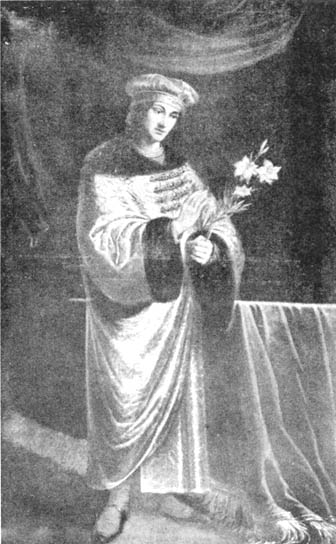
Figure 1.
St. Casimir. Painting. Roman Catholic parish church, Viduklė (Žemaitija).
Litauen-Archiv Dr. P. Rėklaitis.
The reproduction of the painting "St. Casimir" and its return to Viduklė indicate that it was equally valued by the Viduklė congregation and by the organizers of the exhibition in Kaunas, perhaps as an original example of an older indigenous artistic tradition. It is fitting to note here that a very similar head of St. Casimir was reproduced as early as 1917.5
The iconographic origin of this painting of St. Casimir, and what in it is iconographically original, became clear to me in 1984 as I was gathering iconographic material about St. Casimir in connection with the 500th anniversary of the saint's death.6 There is no doubt that the painting in Viduklė is a free copying of the most famous 17th century painting of St. Casimir in Poland, which to this day is in the Church of St. Casimir in Cracow (Figures 2 and 3). 7 The church is familiarly called the Reformed Fathers' church, after an order of Franciscan friars whose monastery was established in Cracow in 1635.8
Not long ago, Polish art historian Krystyna Bartel published a comprehensive study of this Cracow painting.9 The painting is found at a side altar, is painted in oil on linen, and is 250 x 140 cm. in size. Its broken and bent upper and lower edges appeared in 1745, as the painting was being installed into the Late Baroque altar. The saint's right hand is raised in a gesture which seems to express leave-taking rather than a sacral blessing. In contrast to traditional form, according to which the saint holds his attributes - the crucifix (faith) and the lily (chastity) each in a separate hand, here the saint holds both in his left hand. The effect of this is that here is portrayed the crucifix "from which white lilies blossomed."10 On the right side of the painting, on a table covered by a cloth, are a bell and a Baroque table clock, and in the background. draperies. The painting's composition and accessories indicate that here is continued the Polish-Lithuanian aristocratic-landed gentry portraiture tradition though adapted to an ecclesiastical-hagiographic theme.
It is clear, too, that the painter knew the 16th century early iconography of St. Casimir. In the painting are details, not present in the 17th cent, artistic formula; for example, the cartouche of the Polish and Lithuanian coat-of-arms incorporated into the saint's brocaded cloak; the cloak's flowing shape; the right hand's gesture; and other details.
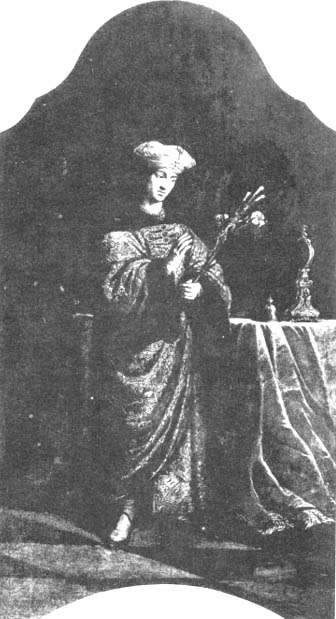
Figure 2.
St. Casimir. Altar picture. Reformed Fathers' Franciscan church, Cracow.
Litauen-Archiv Dr. P. Rėklaitis.
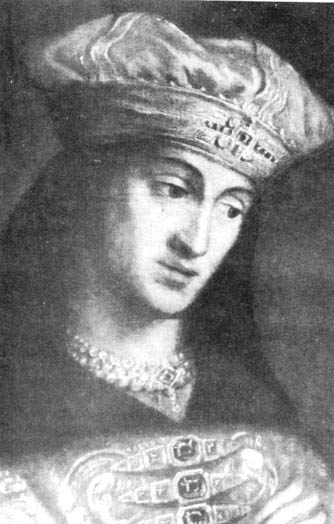
Figure 3.
Detail of the portrait of St. Casimir, Cracow.
Compare these with the painting from the church in Galicia (Figure 4), which still reflects the 16th century formula.11 On the whole, in the painting, the many adornments of the saint's dress are painstakingly and magisterially done; his princely hat and throat are decorated with jewels. This luxury contrasts with the seeming resignation of the saint's tilted head and the melancholy expression of his face (Figure 3). These facial characteristics testify to the artists' attempt to convey traits of the Jogaila and Habsburg families, which are known from other ancestral portraits, for an authentic portrait of St. Casimir has not survived.
The whole and the manner of execution affirm that the work is the product of a highly skilled master, completed after much study. His name, though, is not indicated by a signature or by other documents. Krystyna Bartel attempted to show that it is the work of Cracow painter Daniel Frecher, an effort disclaimed by Mariusz Karpowicz, who indicated another possible painter Daniel Schultz (Szulc), whom he counts among the greatest 17th century psychological portraitists after Rembrandt. Daniel Schultz was born in 1615 in Danzig and died there in 1683, having perfected his art in Flanders and in France. Being court painter to King John Casimir (1609-1672), he also paid attention to local tradition.12 From historical sources it is known that Schultz, in 1669, had painted St. Casimir's portrait, which vanished in France; a painting in Paris by Schultz was also in the St. Germain-des-Pres church's St. Casimir Chapel; and, in like fashion, King John Casimir, until his death kept a portrait of St. Casimir near at hand, perhaps a portrait created by the same painter.13 It is highly probable that the painting which had disappeared in France and his painting in Cracow were replicas of the same original. The Reformed Fathers'-
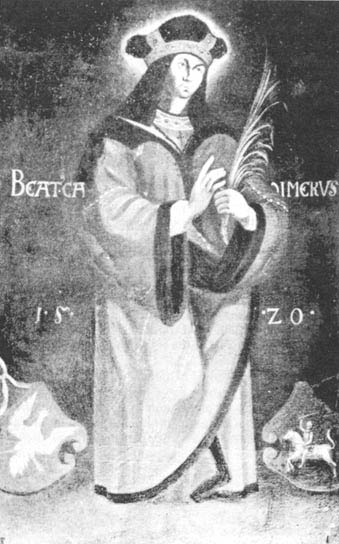
Figure 4.
St. Casimir. Painting in the Catholic church, Galicia.
Litauen-Archiv Dr. P. Rėklaitis.
Franciscans' church in Cracow burned during the war with Sweden in 1655. After the war, it was rebuilt in a Baroque style and was consecrated in 1672. It is believed that Daniel Schultz's painting was given to the monastery during that year by King John Casimir.14 Therefore, it was painted in 1672, if not earlier.
Daniel Schultz's Cracovian portrait of St. Casimir received wide notice. In the 17th century and later, copies and variants were made for Polish churches in a variety of places; in the literature consulted are mentioned Kazimierz Dolny, Lezajsk (Rzeszov district), Pilica (Cracow district), Luszczow (Lublin district), and other locations.15 The portrait of St. Casimir in Žemaitija's Viduklė should be linked to these: its compositional whole fully repeats the Cracow painting, but in its details nonetheless are marked differences (Figure 1). First of all, though the form of the head is repeated, the expression of the face differs: in the Žemaitija portrait of St. Casimir it is more optimistic, less ascetic and melancholy, while in decorative details, in place of the angular jewels, are three strands of round pearls around the neck. Most interesting is the fact that the left hand holds only a branch of lilies and the saint's other attribute the crucifix introduced at the beginning of the 17th century, is nowhere to be seen.
The joining together of both attributes the crucifix and the lily in one hand has an earlier example in Lithuania, in a book illustration in a volume published in Vilnius in 1671: Professor of Rhetoric and Jesuit Father Andriejus Mlodzianovski's Suppet/ae Militares ex Divis Poloniae Lituanaeque Gentis Titularibus.16 There are thirty-three illustrations in the book portraits of saints most likely prepared at the fine arts-engraving workshop in Vilnius of the Schnops family, who had emigrated from the Netherlands.17 The very first engraving "St. Casimir" portrays the saint, based on the painting's iconographic content, just as he is portrayed in the paintings discussed here: a melancholy face, head tilted to the left, both attributes held in one hand as if they had blended to one (Figure 5). A four-line poem beneath the illustration has much significance for the iconography, for it comments on the meaning of the joining of the attributes:
Augustae Natum Casimirus Virginis, inter
Lilis, Parthenij sceptra pudoris habet.
A ligno regnare Deum, ne dicite tanturn:
Rex et ab hoc dici, cur modo flore nequit?
In translation:
Casimir holds the unspoiled sceptre of modesty
of the nobly born Virgin, who is pure as a lily.
Do not say that God rules only from the tree:
Why can He not be called King as well from this flower?18
We can say that these four lines anticipate the Viduklė portrait's realized variant, in which only the lily is depicted. In that way, the Viduklė portrait's difference from the others finds an explanation in the hagiographic expression which arose in Lithuania.
Translated by J.Z.
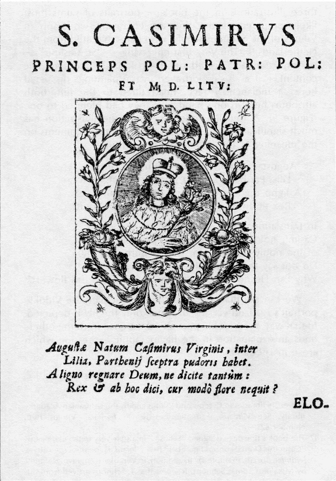
Figure 5.
St. Casimir, from A. Mlodzianovski's Suppetiae militares (Vilnius 1677).
Litauen-Archiv Dr. P. Rėklaitis.
1 Paulius Galaunė, "Mūsų senasis bažnytinis menas," Židinys, Vol. 14, Kaunas 1931, pp. 46-48; picture follows p. 32: "Šv.
Kazimieras. Iš Viduklės bažnyčios, l. Lietuvos bažnytinio meno paroda."
2 Adolfas Sabaliauskas, "Žemaičių meno keliais," Naujoji Romuva, Kaunas 1938, Numbers 40 and 41; Lux Christi, Putnam 1953, Number 8, between pp. 40 and 41; Lietuvių
enciklopedija, South Boston, Mass., 1954, Vol. 2, p. 314.
3 550 metų krikščionybės įvedimui Lietuvoje ir 20 metų Lietuvos nepriklausomybei paminėti Bažnytinio Meno
paroda. Bažnytinio meno draugija, Kaunas: Bažnytinio meno muziejus 1939.
4 Katalikų kalendorius žinynas 1984 (A). Kaunas-Vilnius, 1984, p. 124.
5 Antoine Viscont (Antanas Viskanta), La Lithuanie religieuse, Paris-Geneva, 1918, after p. 128; Simas Sužiedėlis, Der heilige Casimir 1458-1484. Zum Gedachtnis seines 500. Todestages. (Aus dem Litauischen ubers. von Alfred Franzkeit.) Stein am
Rhein: Christiana-Verlag, 1984, p. 2.
6 P. Rėklaitis, "Prie šv. Kazimiero ikonografijos," Aidai, 1984, Numbers 3 and 4; about the exhibit: "Sv. Kazimiero
ikonografija," Europos lietuvis, London, 1984, VII 17 d., p. 2.
7 Michal Walicki, Wladyslaw Tomkiewicz, .Andrzej Ryszkiewicz, Malarst-wo polskie. Manieryzm barok, Warsaw 1971, pp. 346-347.
8 Jan Pasiecznik, Kosciol i klasztor reformatow w Krakowie (Biblioteka krakowska 119), Cracow 1978, p. 17.
9 Krystyna Bartel, "Obraz sw. Kazimierza w kosciele 00. Reformatow w
Krakowie," Biuletyn historii sztuki, Rok 30, Nr. 1, Warsaw 1968, pp. 62-73.
10 Bad Wohrishofen 1984, Number 1. The engraving of St. Casimir in Fra Hilarione's book (Naples 1629) differs from 17th century normal forms in that both attributes are in the right hand. See Aidai, 1984, Number 4.
11 Fryderik Papee, "O najstarszych wizerunkach sw. Kazimierza," Kwartal-nik historiczny Vol. 19, Lwow 1905, pp. 436-437.
12 Mariusz Karpowicz, "Malarz krola Jana Kazimierza," Biuletin historii sztuki, 55. Warsaw 1973, Numbers 3-4.
13 W. Mannowski, Thieme-Becker, Algg. Lex. d. bild., Kunstler, Vol. 30, Leipzig 1936, p. 325; see also
Walicki, pp. 347-359.
14 Karpowicz, op. cit. p. 323; Pasiecznik, op. cit. p. 84-85.
15 Walicki, op. cit. p. 346
16 Suppetiae militares ex Divis Poloniae Lituanaeq. Gentis Tutilaribus, nec non Sanctis Militibus scriptae et Illustrissimo Domino Dno Michaeli Pac Palatinus Vilnensi Siipremo M.D.L. Exercituum Dud, Dinemburgensi, Fejdanensi, Merecensi etc. Capitaneo, Regiae Oeconomiae Mohilowen-sis Administratori oblatae ab Andrea Mlodzianovski Societatis lesu 7677. The original volume is in the author's private collection
(Litauen-Archiv-Reklaitis No. 2315). The book was also held by private libraries and by the
University libraries in Cracow and Vilnius and by the Lithuanian Academy library. See Vilniaus akademijos spaustuvės
leidiniai, Vilnius 1970, Number 625.
17 The book's title page is signed "Sch. sc." in a style very much like that of "Casimirus Dom. Schnops figurabat" (see Vilniaus akademijos spaustuves leidiniai, op. cit., example 3). In addition, in Vilnius are engravings signed by Mikalojus Tomas
Schnops. It seems that T. Schnops arrived from the Netherlands through Hungary: see
Thieme-Becker, op. cit., Vol. 30, p. 206.
18 I am most grateful to Father Paulius Rabikauskas (Rome) for the translation (into Lithuanian) of this difficult baroque-metaphorical four-line poem.